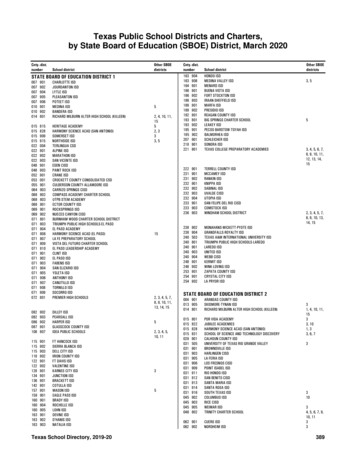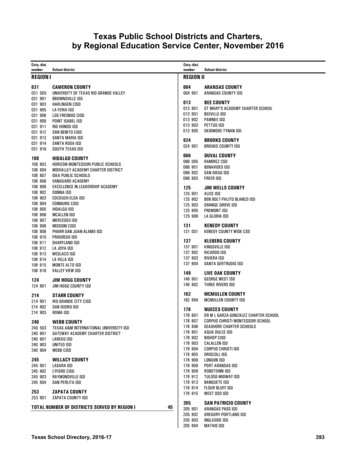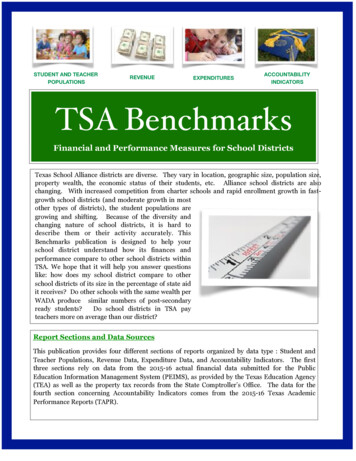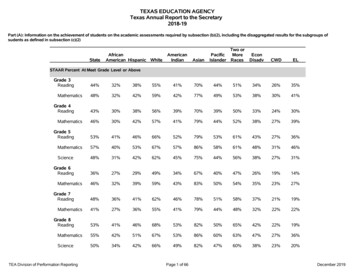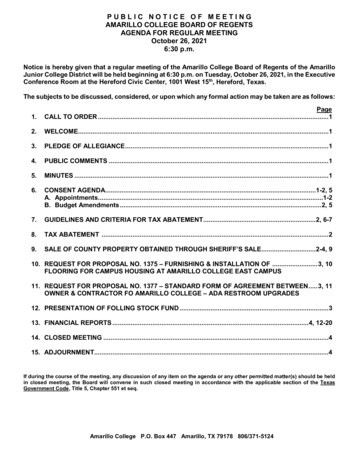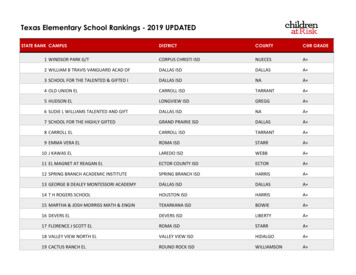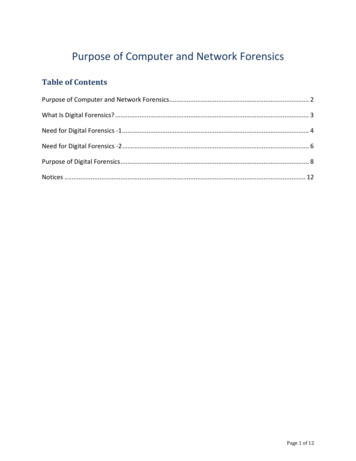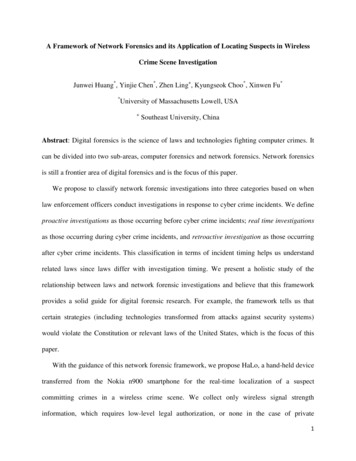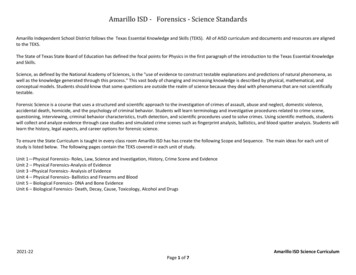
Transcription
Amarillo ISD - Forensics - Science StandardsAmarillo Independent School District follows the Texas Essential Knowledge and Skills (TEKS). All of AISD curriculum and documents and resources are alignedto the TEKS.The State of Texas State Board of Education has defined the focal points for Physics in the first paragraph of the introduction to the Texas Essential Knowledgeand Skills.Science, as defined by the National Academy of Sciences, is the "use of evidence to construct testable explanations and predictions of natural phenomena, aswell as the knowledge generated through this process." This vast body of changing and increasing knowledge is described by physical, mathematical, andconceptual models. Students should know that some questions are outside the realm of science because they deal with phenomena that are not scientificallytestable.Forensic Science is a course that uses a structured and scientific approach to the investigation of crimes of assault, abuse and neglect, domestic violence,accidental death, homicide, and the psychology of criminal behavior. Students will learn terminology and investigative procedures related to crime scene,questioning, interviewing, criminal behavior characteristics, truth detection, and scientific procedures used to solve crimes. Using scientific methods, studentswill collect and analyze evidence through case studies and simulated crime scenes such as fingerprint analysis, ballistics, and blood spatter analysis. Students willlearn the history, legal aspects, and career options for forensic science.To ensure the State Curriculum is taught in every class room Amarillo ISD has has create the following Scope and Sequence. The main ideas for each unit ofstudy is listed below. The following pages contain the TEKS covered in each unit of study.Unit 1—Physical Forensics- Roles, Law, Science and Investigation, History, Crime Scene and EvidenceUnit 2 – Physical Forensics-Analysis of EvidenceUnit 3 –Physical Forensics- Analysis of EvidenceUnit 4 – Physical Forensics- Ballistics and Firearms and BloodUnit 5 – Biological Forensics- DNA and Bone EvidenceUnit 6 – Biological Forensics- Death, Decay, Cause, Toxicology, Alcohol and Drugs2021-22Amarillo ISD Science CurriculumPage 1 of 7
Amarillo ISD - Forensics - Science StandardsFirst SemesterUnit 1 Physical Forensics- Roles, Law, Science and Investigation, History, Crime Scene and EvidenceFS.01 The student demonstrates professionalstandards/employability skills as required bybusiness and industry. The student is expected toachieve business and industry employability skillsstandards such as attendance, punctuality,meeting deadlines, working toward personal/teamgoals every day, and ethical use of technology.FS.02 The student, for at least 40% ofinstructional time, conductslaboratory and/or field investigations using safe,environmentally appropriate, and ethical practices.The student is expected to:FS.03 The student uses scientific methods andequipment during laboratory and fieldinvestigations. The student is expected to:28 days(A) demonstrate safe practices during laboratory and field investigations; and(B) demonstrate an understanding of the use and conservation of resources and the properdisposal or recycling of materials.(A) know the definition of science and understand that it has limitations, as specified insubsection (b)(4) of this section;(B) know that scientific hypotheses are tentative and testable statements that must be capable ofbeing supported or not supported by observational evidence. Hypotheses of durableexplanatory power that have been tested over a wide variety of conditions are incorporatedinto theories;(C) know scientific theories are based on natural and physical phenomena and are capable ofbeing tested by multiple independent researchers. Unlike hypotheses, scientific theories arewell-established and highly reliable explanations, but they may be subject to change as newareas of science and new technologies are developed;(D) distinguish between scientific hypotheses and scientific theories;(E) plan and implement descriptive, comparative, and experimental investigations, includingasking questions, formulating testable hypotheses, and selecting equipment and technology;(F) collect and organize qualitative and quantitative data and make measurements with accuracyand precision using tools such as calculators, spreadsheet software, data-collecting probes,computers, standard laboratory glassware, microscopes, various prepared slides,stereoscopes, metric rulers, electronic balances, gel electrophoresis apparatuses,micropipettors, hand lenses, Celsius thermometers, hot plates, lab notebooks or journals,2021-22Amarillo ISD Science CurriculumPage 2 of 7
Amarillo ISD - Forensics - Science StandardsFS.04 The student uses critical thinking, scientificreasoning, and problem solving to make informeddecisions within and outside the classroom. Thestudent is expected to:FS.05 The student explores the history,legal aspects, and career options within forensicscience. The student is expected to:FS.08 The student analyzes impression evidence inforensic science. The student is expected to:Unit 2 – Physical Forensics- Analysis of Evidencetiming devices, cameras, Petri dishes, lab incubators, dissection equipment, meter sticks, andmodels, diagrams, or samples of biological specimens or structures;(H) communicate valid conclusions supported by the data through methods such as investigativereports, lab reports, labeled drawings, graphic organizers, journals, summaries, oral reports,and technology-based reports.(A) analyze, evaluate, and critique scientific explanations by using empirical evidence, logicalreasoning, and experimental and observational testing, including examining all sides ofscientific evidence of those scientific explanations, to encourage critical thinking;(B) communicate and apply scientific information extracted from various sources such as currentevents, news reports, published journal articles, and marketing materials;(C) draw inferences based on data related to criminal investigation;(D) evaluate the impact of scientific research on criminal investigation, society, and theenvironment;(E) evaluate models according to their limitations in representing biological objects or events; and(F) research and describe the history of science and contributions of scientists within the criminaljustice system.(A) distinguish between criminalistics and criminology;(B) identify and illustrate roles, functions, and responsibilities of different forensicscience disciplines such as serology-DNA, controlled substances, toxicology, trace evidence,firearms, fingerprints, and questioned documents(A) compare the three major fingerprint patterns of arches, loops, and whorls and theirrespective subclasses;(B) identify the minutiae of fingerprints, including bifurcations, ending ridges, dots, short ridges,and enclosures;(C) distinguish among patent, plastic, and latent impressions;(D) perform laboratory procedures for lifting latent prints on porous and nonporous objects usingchemicals such as iodine, ninhydrin, silver nitrate, and cyanoacrylate resin;(E) perform laboratory procedures for lifting latent prints on nonporous objects using fingerprintpowders such as black powder and florescent powders;(F) explain the Automated Fingerprint Identification System (AFIS) and describe thecharacteristics examined in the AFIS; and(G) compare impression evidence collected at a simulated crime scene with the knownimpression.28 days2021-22Amarillo ISD Science CurriculumPage 3 of 7
Amarillo ISD - Forensics - Science StandardsFS.07 The student recognizes the methods toprocess and analyze trace evidence commonlyfound in a crime scene. The student is expected to:(B) compare and contrast the composition of various types of glass such as soda lime,borosilicate, leaded, and tempered;(C) determine the direction of a projectile by examining glass fractures;(D) define refractive index and explain how it is used in forensic glass analysis;FS.14 The student evaluates bullet and tool markimpressions in a criminal investigation. Thestudent is expected to:Unit 3 - Physical Forensics- Analysis of Evidence(A) explain the individual characteristics of tool marks;FS.06 The student recognizes the procedures ofevidence collection while maintaining the integrityof a crime scene. The student is expected to:FS.07 The student recognizes the methods toprocess and analyze trace evidence commonlyfound in a crime scene. The student is expected to:26.5 days(A) compare and contrast the roles of forensic scientists and crime scene investigators;(B) demonstrate the ability to work as a member of a team;(C) conduct a systematic search of a simulated crime scene for physical evidence following crimescene search patterns such as spiral, line, grid, and strip;(D) apply knowledge of the elements of criminal law that guide search and seizure of persons,property, and evidence;(E) describe the elements of a crime scene sketch such as measurements, compass directions,scale of proportion, legend-key, and title;(F) develop a crime scene sketch using coordinates/measurements from fixed points;(G) outline the chain of custody procedure for evidence discovered in a crime scene; and(H) demonstrate proper techniques for collecting, packaging, and preserving physical evidencefound at a crime scene.(A) demonstrate how to process trace evidence such as glass, paint, fibers, hair, soil, grass, andblood collected in a simulated crime scene;(B) compare and contrast the composition of various types of glass such as soda lime,borosilicate, leaded, and tempered;(C) determine the direction of a projectile by examining glass fractures;(D) define refractive index and explain how it is used in forensic glass analysis;(E) describe the instrumental analysis of trace evidence such as microscopy and spectrometry;(F) compare and contrast the microscopic characteristics of human hair and animal hair, includingmedulla, pigment distribution, and scales;(G) describe and illustrate the different microscopic characteristics used to determine the racialand somatic origin of a human hair sample;(H) differentiate between natural and synthetic fibers; and(I) describe various examinations performed in forensic paint analysis, including microscopicmorphology, binder, and pigment characterization.2021-22Amarillo ISD Science CurriculumPage 4 of 7
Amarillo ISD - Forensics - Science StandardsUnit 4 – Physical Forensics- Ballistics and Firearms and BloodFS.07 The student recognizes the methods toprocess and analyze trace evidence commonlyfound in a crime scene. The student is expected to:FS.09 The student analyzes blood spatter at asimulated crime scene. The student is expected to:FS.10 The student explores toxicology laboratoryprocedures in forensic science. The student isexpected to:FS.11 The student explores serology laboratoryprocedures in forensic science. The student isexpected to:FS.14 The student evaluates bullet and tool markimpressions in a criminal investigation. Thestudent is expected to:Unit 5 – Biological Forensics- DNA and Bone Evidence28 days(B) compare and contrast the composition of various types of glass such as soda lime,borosilicate, leaded, and tempered;(A) analyze blood stain patterns based on source, direction, and angle of trajectory; and(B) explain the method of chemically isolating an invisible blood stain using reagents such asluminol.(D) explain the precautions necessary in the forensic laboratory for proper preservation of bloodsamples.(A) explain forensic laboratory procedures to determine if a stain detected in a crime scene isblood;(B) identify the red blood cell antigens and antibodies as they relate to human blood types;(C) determine genotypes and phenotypes in the human red blood cell system using PunnetSquares; and(D) research methodologies used to collect and analyze other body fluids(B) describe the mechanism of modern firearms;(C) recognize characteristics of bullet and cartridge cases;(D) describe the composition of and method of analysis for gunshot residue and primer residue;(E) recognize the type of information available through the National Integrated BallisticsInformation Network.29 daysFS.12 The student analyzes deoxyribonucleic acid(DNA) laboratory procedures in forensic science.The student is expected to:(A) describe the structure of a DNA molecule and its function;(B) describe the steps used in extraction of DNA;(C) explain the analytical procedure for forensic DNA typing, including electrophoresis,polymerase chain reaction, and short tandem repeat; and(D) interpret the components of an electropherogram.FS.15 The student explores principles ofquestioned document analysis in forensic science.The student is expected to:(A) describe different types of examinations performed by a questioned document examiner in aforensic laboratory, including counterfeiting, handwriting, ink, and paper analysis;(B) describe the security features incorporated in the U.S. currency to prevent counterfeiting;(C) perform handwriting comparisons of an unknown sample with exemplars by analyzingcharacteristics such as letter, line, and formatting; and(D) describe the process of ink analysis using chromatography.2021-22Amarillo ISD Science CurriculumPage 5 of 7
Amarillo ISD - Forensics - Science StandardsFS.16 The student explores principles ofanthropology relevant to forensic science. Thestudent is expected to:(A)(B)(C)(D)identify the major bones of the human skeletal system;compare composition and structure of human bones with other animals;describe the techniques used to excavate bones from a crime scene;explain the characteristics of the human skeletal system indicative of specific gender, racialorigin, and approximate range of age and height; and(E) explain the role of dental records in identification of human remains.FS.17 The student calculates the time and cause(A) explain the process and timeline of rigor mortis and its role in calculating time of death;of death in relationship to decomposition of the(B) explain post mortem lividity and its importance when processing a crime scene;human body. The student is expected to:(C) determine time of death using entomology; and(D) determine time and cause of death methodologies through case studies.Unit 6 – Biological Forensics- Death, Decay, Cause, Toxicology, Alcohol and Drugs33.5 daysFS.04 The student uses critical thinking, scientificreasoning, and problem solving to make informeddecisions within and outside the classroom. Thestudent is expected to:FS.05 The student explores the history,legal aspects, and career options within forensicscience. The student is expected to:FS.10 The student explores toxicology laboratoryprocedures in forensic science. The student isexpected to:(D) evaluate the impact of scientific research on criminal investigation, society, and theenvironment;FS.13 The student identifies drugs found at asimulated crime scene. The student is expected to:(D) identify and illustrate roles, functions, and responsibilities of professionals in the criminaljustice system, including crime scene investigators, criminalists, attorneys, and medicalexaminers;(A) explain the absorption, distribution, and elimination of alcohol through the human body;(B) describe the blood alcohol laboratory procedures as they relate to blood alcoholconcentration;(C) explain the levels of tolerance and impairment due to alcohol consumption; and(D) explain the precautions necessary in the forensic laboratory for proper preservation of bloodsamples.(A) classify controlled substances using the schedules under the Controlled Substances Act; and(B) identify controlled substances using laboratory procedures such as microchemicaltests, microscopy, chromatography, and spectrophotometry.2021-22Amarillo ISD Science CurriculumPage 6 of 7
Amarillo ISD - Forensics - Science StandardsTo ensure that every student has an opportunity to learn, understand and demonstrate the Texas Essential Knowledge and Skills. Amarillo Independent hasadopted the following protocols for teachers, curriculum and others to use in reference to Curriculum, Instruction and Assessment.Curriculum1) Prioritize essential learning based on AISD written curriculum and adhere to the scope and sequence.2) Develop deep understandings of the AISD written curriculum with an emphasis on the essential learning outcomes.3) Create relevant learning environments in every classroom using the AISD written curriculum.4) Analyze vertical and horizontal alignment to ensure grade level curriculum is being taught.Instruction1) Common lessons are developed based on strategically selected grade level TEKS and include learning opportunities for students that:are at the expected level of thinking and rigorutilize research based instructional strategiesare actively engaginghave real world applications2) Collaboratively align instruction to assessment.3) Individual student instructional needs are considered and addressed in the lessons.4) Strategic re-teaching when students do not understand.5) Common lessons are analyzed and strengthened through a continuous improvement process such as the Professional Teaching Model, Lesson Studyor other method for collaborative study and sharing.Assessment1) Collaboratively align all assessment to the AISD written curriculum and reflect appropriate rigor.2) Collaboratively engage in purposeful dialogue about assessment tied to clearly defined essential learning outcomes.3) Continuously improve and adjust instruction based on common assessment results and student work.4) Provide feedback to the annual curriculum feedback and revision process2021-22Amarillo ISD Science CurriculumPage 7 of 7
Amarillo Independent School District follows the Texas Essential Knowledge and Skills (TEKS). . and Skills. Science, as defined by the National Academy of Sciences, is the "use of evidence to construct testable explanations and predictions of natural phenomena, as . Forensic Science is a course that uses a structured and scientific approach .

